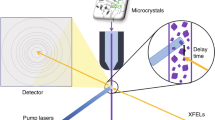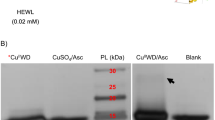Abstract
Proteins can misfold into amyloid structures that are associated with diseases; however, the same proteins often have important biological roles. To degrade selectively the amyloid form without affecting the fraction of functional protein is, therefore, an attractive goal. Here we report target-state-dependent photooxygenation catalysts that are active only when bound to the cross-β-sheet structure that is characteristic of pathogenic aggregated amyloid proteins. We show these catalysts can selectively oxygenate the amyloid form of amyloid β-protein (Aβ) 1–42 in the presence of non-amyloid off-target substrates. Furthermore, photooxygenation with a catalyst that bears an Aβ-binding peptide attenuated the Aβ pathogenicity in the presence of cells. We also show that selective photooxygenation is generally applicable to other amyloidogenic proteins (amylin, insulin, β2-microglobulin, transthyretin and α-synuclein) and does not affect the physiologically functional non-aggregate states of these proteins. This is the first report of an artificial catalyst that can be selectively and reversibly turned on and off depending on the structure and aggregation state of the substrate protein.
This is a preview of subscription content, access via your institution
Access options
Subscribe to this journal
Receive 12 print issues and online access
$259.00 per year
only $21.58 per issue
Buy this article
- Purchase on Springer Link
- Instant access to full article PDF
Prices may be subject to local taxes which are calculated during checkout





Similar content being viewed by others
References
Takaoka, Y., Ojida, A. & Hamachi, I. Protein organic chemistry and applications for labeling and engineering in live-cell systems. Angew. Chem. Int. Ed. 52, 4088–4106 (2013).
Spicer, C. D. & Davis, B. G. Selective chemical protein modification. Nature Commun. 5, 4740 (2014).
Chen, Z. et al. Catalytic protein modification with dirhodium metallopeptides: specificity in designed and natural systems. J. Am. Chem. Soc. 134, 10138–10145 (2012).
Sato, S. & Nakamura, H. Ligand-directed selective protein modification based on local single-electron-transfer catalysis. Angew. Chem. Int. Ed. 52, 8681–8684 (2013).
Yamaguchi, T. et al. Turn-ON fluorescent affinity labeling using a small bifunctional O-nitrobenzoxadiazole unit. Chem. Sci. 5, 1021–1029 (2014).
Lee, T. Y. & Suh, J. Target-selective peptide-cleaving catalysts as a new paradigm in drug design. Chem. Soc. Rev. 38, 1949–1957 (2009).
Prakash, J. & Kodanko, J. J. Metal-based methods for protein inactivation. Curr. Opin. Chem. Biol. 17, 197–203 (2013).
Taniguchi, A. et al. Attenuation of the aggregation and neurotoxicity of amyloid-β peptides by catalytic photooxygenation. Angew. Chem. Int. Ed. 53, 1382–1385 (2014).
Klein, W. L., Krafft, G. A. & Finch, C. E. Targeting small Aβ oligomers: the solution to an Alzheimer's disease conundrum? Trends Neurosci. 24, 219–224 (2001).
Selkoe, D. J. Soluble oligomers of the amyloid β-protein impair synaptic plasticity and behavior. Behav. Brain Res. 192, 106–113 (2008).
Benilova, I., Karran, E. & De Strooper, B. The toxic Aβ oligomer and Alzheimer's disease: an emperor in need of clothes. Nature Neurosci. 15, 349–357 (2012).
Chiti, F. C. & Dobson, M. Protein misfolding, functional amyloid, and human disease. Annu. Rev. Biochem. 75, 333–366 (2006).
Uversky, V. N. et al. Methionine oxidation inhibits fibrillation of human α-synuclein in vitro. FEBS Lett. 517, 239–244 (2002).
Butterfield, D. A. & Boyd-Kimball, D. The critical role of methionine 35 in Alzheimer's amyloid β-peptide (1-42)-induced oxidative stress and neurotoxicity. Biochim. Biophys. Acta Proteins Proteomics 1703, 149–156 (2004).
Breydo, L. et al. Methionine oxidation interferes with conversion of the prion protein into the fibrillar proteinase K-resistant conformation. Biochemistry 44, 15534–15543 (2005).
Maleknia, S. D., Reixach, N. & Buxbaum, J. N. Oxidation inhibits amyloid fibril formation of transthyretin. FEBS J. 273, 5400–5406 (2006).
Binger, K. J., Griffin, M. D. & Howlett, G. J. Methionine oxidation inhibits assembly and promotes disassembly of apolipoprotein C-II amyloid fibrils. Biochemistry 47, 10208–10217 (2008).
Chimon, S. et al. Evidence of fibril-like β-sheet structures in a neurotoxic amyloid intermediate of Alzheimer's β-amyloid. Nature Struct. Mol. Biol. 14, 1157–1164 (2007).
Stroud, J. C., Liu, C., Teng, P. K. & Eisenberg, D. Toxic fibrillar oligomers of amyloid-β have cross-β structure. Proc. Natl Acad. Sci. USA 109, 7717–7722 (2012).
Walsh, D. M. et al. Amyloid β-protein fibrillogenesis. Structure and biological activity of protofibrillar intermediates. J. Biol. Chem. 274, 25945–25952 (1999).
Jan, A. et al. Aβ42 neurotoxicity is mediated by ongoing nucleated polymerization process rather than by discrete Aβ42 species. J. Biol. Chem. 286, 8585–8596 (2011).
Qiang, W., Yau, W. M., Luo, Y. Q., Mattson, M. P. & Tycko, R. Antiparallel β-sheet architecture in Iowa-mutant β-amyloid fibrils. Proc. Natl Acad. Sci. USA 109, 4443–4448 (2012).
Amdursky, N., Erez, Y. & Huppert, D. Molecular rotors: what lies behind the high sensitivity of the thioflavin-T fluorescent marker. Acc. Chem. Res. 45, 1548–1557 (2012).
McClure, D. S. Triplet-singlet transitions in organic molecules. Lifetime measurements of the triplet state. J. Chem. Phys. 17, 905–913 (1949).
Buell, A. K., Dobson, C. M. & Welland, M. E. Measuring the kinetics of amyloid fibril elongation using quartz crystal microbalances. Methods Mol. Biol. 849, 101–119 (2012).
Balducci, C. et al. Synthetic amyloid-β oligomers impair long-term memory independently of cellular prion protein. Proc. Natl Acad. Sci. USA 107, 2295–2300 (2010).
Stsiapura, V. I. et al. Thioflavin T as a molecular rotor: fluorescent properties of thioflavin T in solvents with different viscosity. J. Phys. Chem. B 112, 15893–15902 (2008).
Haag, W. R., Hoigne, J., Gassman, E. & Braun, A. M. Singlet oxygen in surface waters. Part I: Furfuryl alcohol as a trapping agent. Chemosphere 13, 631–640 (1984).
Mishra, R., Sjölander, D. & Hammarström, P. Spectroscopic characterization of diverse amyloid fibrils in vitro by the fluorescent dye Nile red. Mol. BioSyst. 7, 1232–1240 (2011).
Greene, L. A. & Tischler, A. S. Establishment of a noradrenergic clonal line of rat adrenal pheochromocytoma cells which respond to nerve growth factor. Proc. Natl Acad. Sci. USA 73, 2424–2428 (1976).
Lorenzo, A., Razzaboni, B., Weir, G. C. & Yankner, B. A. Pancreatic islet cell toxicity of amylin associated with type-2 diabetes mellitus. Nature 368, 756–760 (1994).
Mauro, M. et al. Kinetics of different processes in human insulin amyloid formation. J. Mol. Biol. 366, 258–274 (2007).
Hua, Q. X. & Weiss, M. A. Mechanism of insulin fibrillation: the structure of insulin under amyloidogenic conditions resembles a protein-folding intermediate. J. Biol. Chem. 279, 21449–21460 (2004).
Sasahara, K. et al. Amyloid nucleation triggered by agitation of β2-microglobulin under acidic and neutral pH conditions. Biochemistry 47, 2650–2660 (2008).
Wiseman, R. L., Powers, E. T. & Kelly, J. W. Partitioning conformational intermediates between competing refolding and aggregation pathways: insights into transthyretin amyloid disease. Biochemistry 44, 16612–16623 (2005).
Uversky, V. N., Li, J. & Fink, A. L. Metal-triggered structural transformations, aggregation, and fibrillation of human α-synuclein. A possible molecular link between Parkinson's disease and heavy metal exposure. J. Biol. Chem. 276, 44284–44296 (2001).
Cheng, B. et al. Inhibiting toxic aggregation of amyloidogenic proteins: a therapeutic strategy for protein misfolding diseases. Biochim. Biophys. Acta 1830, 4860–4871 (2013).
Gestwicki, J. E., Crabtree, G. R. & Graef, I. A. Harnessing chaperones to generate small-molecule inhibitors of amyloid β aggregation. Science 306, 865–869 (2004).
Triesscheijn, M., Baas, P., Schellens, J. H. M. & Stewart, F. A. Photodynamic therapy in oncology. Oncologist 11, 1034–1044 (2006).
Kim, T.-I. et al. Injectable, cellular-scale optoelectronics with applications for wireless optogenetics. Science 340, 211–216 (2013).
Kalia, S. K., Sankar, T. & Lozano, A. M. Deep brain stimulation for Parkinson's disease and other movement disorders. Cur. Opin. Neurol. 26, 374–380 (2013).
Wua, N., Raoa, X., Gao, Y., Wang, J. & Xu, F. Amyloid-β deposition and olfactory dysfunction in an Alzheimer's disease model. J. Alzheimer's Dis. 37, 699–712 (2013).
Peelaerts, W. et al. α-Synuclein strains cause distinct synucleinopathies after local and systemic administration. Nature 522, 340–344 (2015).
Colon, W. & Kelly, J. W. Partial denaturation of transthyretin is sufficient for amyloid fibril formation in vitro. Biochemistry 31, 8654–8660 (1992).
Acknowledgements
This work was supported in part by ERATO from JST. We thank T. Katada and K. Kontani, I. Shimada and M. Kato (The University of Tokyo) for access to the ultracentrifuge, CD spectroscopy and AFM, respectively. We are grateful to Y. Goto and T. Ikenoue (Osaka University) for providing advice on the aggregation experiments of α-synuclein. We are grateful to T. Tomita, Y. Hori, K. Hanaoka and T. Komatsu (The University of Tokyo) for fruitful discussions.
Author information
Authors and Affiliations
Contributions
A.T., Y.So. and M.K. conceived and designed the research. A.T. performed all the experiments and Y.Sh. synthesized catalyst 3. A.T., K.O., Y.So. and M.K. analysed the data. A.T., Y.So. and M.K. co-wrote the paper. All the authors discussed the results and commented on the manuscript.
Corresponding authors
Ethics declarations
Competing interests
The authors declare no competing financial interests.
Supplementary information
Supplementary information
Supplementary information (PDF 5743 kb)
Rights and permissions
About this article
Cite this article
Taniguchi, A., Shimizu, Y., Oisaki, K. et al. Switchable photooxygenation catalysts that sense higher-order amyloid structures. Nature Chem 8, 974–982 (2016). https://doi.org/10.1038/nchem.2550
Received:
Accepted:
Published:
Issue Date:
DOI: https://doi.org/10.1038/nchem.2550




